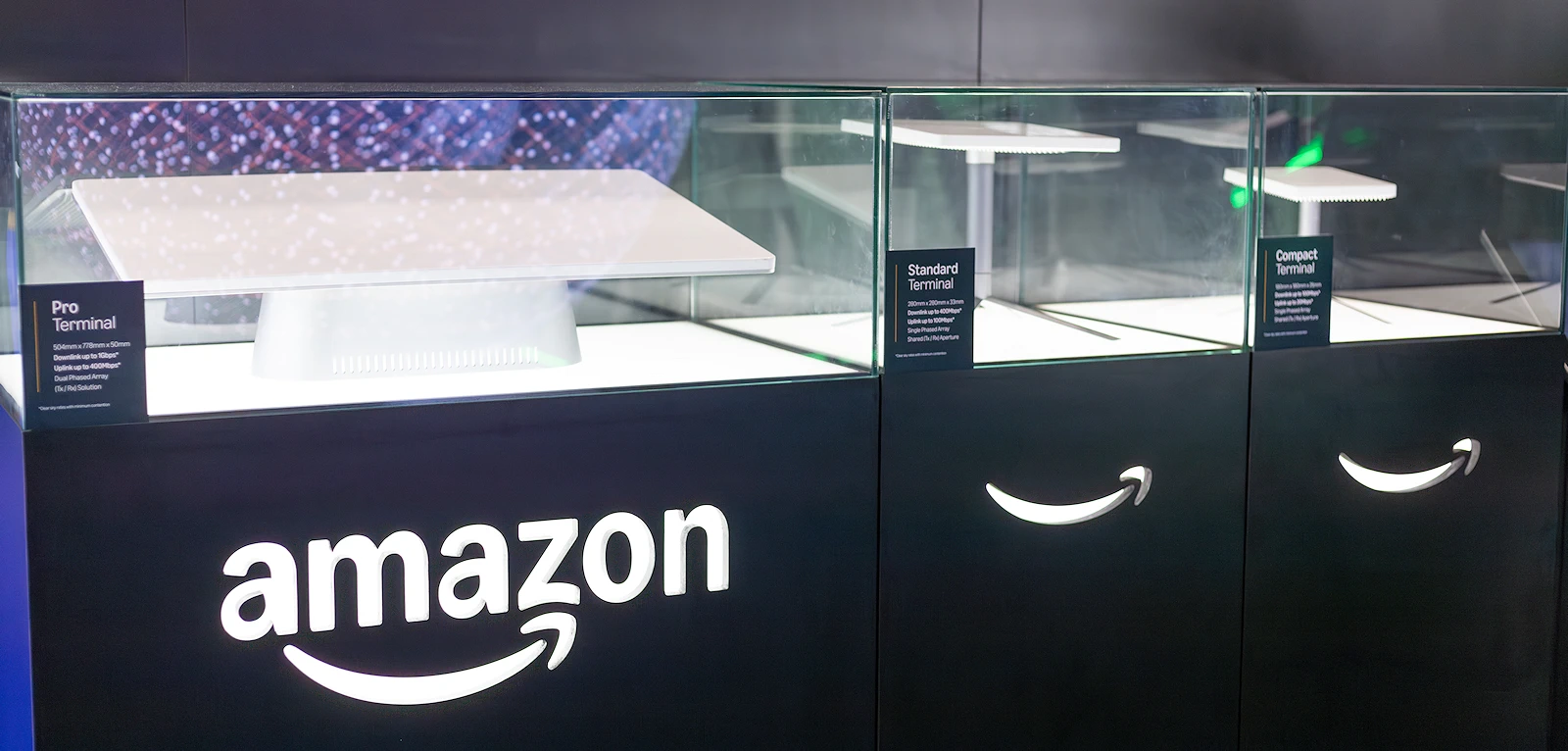A Look at Amazon’s Project Kuiper Satellite Broadband Terminals and Speeds

Internet retail giant Amazon recently turned up at the UK’s DSEI 2025 Defence Exhibition & Trade Show in London to showcase their Project Kuiper network of ultrafast broadband satellites in Low Earth Orbit (LEO). The good news is that some of ISPreview’s readers were there and managed to collect a few new details on service speeds and network terminals.
Amazon currently has approval to deploy and operate their own constellation of 3,236 LEO satellites as part of Project Kuiper. The company has in fact already launched 104 satellites into orbit (altitudes of around 590km to 630km), including two of their initial prototypes – Kuipersat-1 and Kuipersat-2. The operator plans to begin a beta test around the end of 2025, but the commercial launch isn’t expected to start until March 2026 – initially in the US, Canada, UK, Germany and France.
Each spacecraft can technically process data traffic at speeds of up to 1Tbps (Terabits per second), albeit shared between many users. Back in 2023 we also learnt that the company were planning to deploy three ground terminals (dishes) to cater for different types of customers (here) – Compact (residential and roaming), Standard (residential and business) and Pro (high demand enterprise, telecoms and governments etc.).
Advertisement
Amazon has previously revealed some of the details for each terminal, such as their size and theoretically download speeds (i.e. clear sky rates on a network with minimum contention). But the details displayed at DSEI included some new information that we hadn’t seen before, such as the upload speed capability of each terminal and a few additional specs. We’ve summarised these further down the page.

Before we get started, it’s worth reminding that the Head of Project Kuiper, Rajeev Badyal, recently conducted an initial round of speed tests using their enterprise-grade customer terminal (Pro). The test clearly showed their ground-based setup hitting a download speed of 1.29Gbps and latency times of 47-48ms (milliseconds), which indicates that the terminals have the ability to perform better than advertised (Pro is designed to handle 1Gbps).
In terms of the new data, we’ll start with a summary of the “Environmental Operating Specs” because they’re virtually identical for each of the three terminals. The exception being the Pro unit, which can deliver a slightly higher (99.5% vs 99%) “Link Availability” during extreme global weather conditions.
Project Kuiper Terminals – Environmental Operating Specs
Link Availability: >99% in extreme global weather conditions (>99.5% on Pro)
Operating Temperature: -30c to +50c (-22f to +122f)
IPRating: IP66
Storage Temperature (Power OFF): -40c to +60c (-40f to +140f) ETSI EN 300 019-1-1 Class 1.2
Operating Humidity: Relative humidity: 5% to 100%
Storage Humidity: 0% to 100% condensing. ETSI EN 300 019-1-1 Class 1.2
The other specs for each of the three terminals can be found below. Credits to ISPreview readers Nat and Tom for providing the photos and specifications from the aformentioned event.
Advertisement
Project Kuiper Customer Terminal Specs (GEN1)
Compact
Peak Download Speed: 100Mbps
Peak Upload Speed: 20Mbps
Size: 18cm x 18cm x 2.5cm
Weight: 1Kg
Data & Power Ports: Ethernet/POE
Antenna: Single Phased Array – Shared (Tx/Rx) ApertureStandard
Peak Download Speed: 400Mbps
Peak Upload Speed: 100Mbps
Size: 28cm x 28cm x 3.3cm
Weight: 2.5Kg
Data & Power Ports: Ethernet/PoE
Antenna: Single Phased Array – Shared (Tx/Rx) AperturePro
Peak Download Speed: 1,000Mbps
Peak Upload Speed: 400Mbps
Size: 50.5cm x 77.8cm x 5cm
Weight: 17Kg
Data & Power Ports: Ethernet (data) + Ethernet (Mgt)
Antenna: Dual Phased Array – (Tx/Rx) Solution
At present we don’t know how well this service, at least in its first generation (GEN1) form, will actually perform once it’s placed under real-world load. In addition, Amazon has yet to release any details about their consumer broadband packages and prices, which will no doubt follow in the near future. But the above information does at least provide a useful indication of what we might be able to expect, performance wise, from the service when operating at its best.
Mark is a professional technology writer, IT consultant and computer engineer from Dorset (England), he also founded ISPreview in 1999 and enjoys analysing the latest telecoms and broadband developments. Find me on X (Twitter), Mastodon, Facebook, BlueSky, Threads.net and Linkedin.
« GoFibre to Grow UK Broadband Engineering Fleet by 140 Vehicles
Advertisement
Leave a Reply Cancel reply
Privacy Notice: Please note that news comments are anonymous, which means that we do NOT require you to enter any real personal details to post a message and display names can be almost anything you like (provided they do not contain offensive language or impersonate a real person�s legal name). By clicking to submit a post you agree to storing your entries for comment content, display name, IP and email in our database, for as long as the post remains live.
Only the submitted name and comment will be displayed in public, while the rest will be kept private (we will never share this outside of ISPreview, regardless of whether the data is real or fake). This comment system uses submitted IP, email and website address data to spot abuse and spammers. All data is transferred via an encrypted (https secure) session.























































It will all depend on monthly price, if fair enough then 100/20 option looks like a proper backup for main fibre connection for nerds like me working from home.
If they’re competing against Starlink hopefully it will drive the price of both services down.
Perhaps they would like to add the nascent service to my Prime benefits 😀